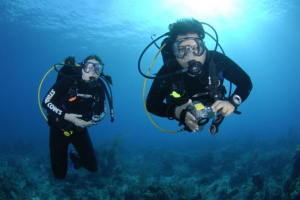
In moving my old blog over to this shiny new home, I ran across my old “Tips and Tricks” page. This is just a simple list of tips and tricks I’ve picked up along the way. I thought it would be a good idea to put them in a single place for all to see. I’ll be adding to these regularly, so stay tuned!
Before the Dive:
When picking up a tank by the valve, make sure you hold it so that the valve opening is facing away from the palm of your hand. This way if your fingers slip a little, you won’t accidentally crack open the tank valve. Trust me, 3000 psi really hurts!
Conserving Air:
- Everything underwater should be done in slow motion.
- The natural orientation for a diver is horizontal, not vertical.
- Try not to use your hands. Keep them folded across your chest. All your propulsion should come from your fins.
- If you have been working hard on the surface or you are just breathing hard, take a moment to relax on the surface before you descend. Scuba is supposed to be a relaxing sport. There is no hurry to get down there.
Descents:
Here are the steps I like to use when making a descent. Make sure you are relaxed on the surface, with the regulator in your mouth:
- Equalize your ears once on the surface to that they are slightly over-pressured.
- Cross your fins and keep them crossed, pointed down and slightly behind you.
- Purge the air from your BCD, and at the same time take in a deep breath.
- While still purging, exhale completely. You should now be sinking and on your way down.
- Do not uncross your fins until your body has naturally assumed a horizontal orientation.
- Do not forget to keep equalizing and letting a little air at a time into your BCD on the way down if you need to slow your descent.
Practice this often in your imagination and it will become second nature in the water.
Equalizing:
- Equalize early and often. This means to do it once while you are on the surface before you descend, and then every couple feet or so on your way down. The first 30 feet are usually the hardest.
- Although the Valsalva maneuver is the one most often taught in open water classes, there exists a number of ways to equalize your ears. If one doesn’t work well for you, just try another. For tips on the many different methods available, watch this video from the University of Washington.
- Practice equalizing several times a day during your normal work-week and you will find that you can soon do this with very little effort.


